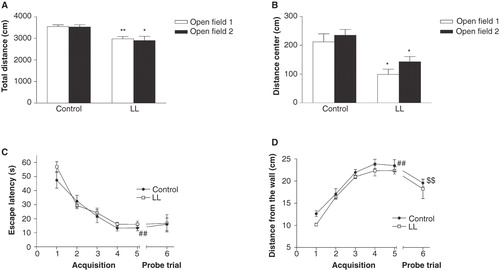Figures & data
Figure 1. A-B: Spontaneous activity of rats exposed to constant light (LL) during the perinatal development or a 12-h light/dark cycle (control) examined in the open field (OF) test. A: The LL-animals had a significantly reduced locomotor activity compared to the control group. Neither of the groups had significantly reduced total distance moved in the arena between the two days. B: The LL-animals traveled a significantly shorter distance in the center compared to controls in both trials, interpreted as higher anxiety-like behavior. C-D: The performance in the water maze (WM) test. C: The escape latency (s), i.e. climbing up on the platform during the acquisition trials, and latency in first visiting the target zone during the probe trial. D: The average wall distance (cm) of the animals, used for interpretation of thigmotactic behavior. Values represent mean ± SEM. * P < 0.05, ** P < 0.01, compared to controls (Mann–Whitney U test); ## P < 0.01 compared to the first acquisition trial; $$ P<0.01 compared to the last acquisition trial (Wilcoxon matched pairs test). Twelve animals per group were tested, and the statistical analysis was based on number of litters (control group n = 12; LL-group n = 4).

Table I. Behavioral parameters recorded during 10 min in the first (A) and second (B) open field (OF) tests in rats exposed to a 12-h light/dark cycle (control) or constant light (LL) during the perinatal development. Values represent mean ± SEM. *P < 0.05, ** P < 0.01 compared to controls (Mann–Whitney U test). Twelve animals per group were tested, and the statistical analysis was based on number of litters (control group n = 12; LL-group n = 4).
Table II. Behavioral parameters recorded during the 90-second probe trial of the water maze (WM) test. Values represent mean ± SEM. * P < 0.05 compared to controls (Mann–Whitney U test). Twelve animals per group were tested, and the statistical analysis was based on number of litters (control group n = 12; LL-group n = 4).
